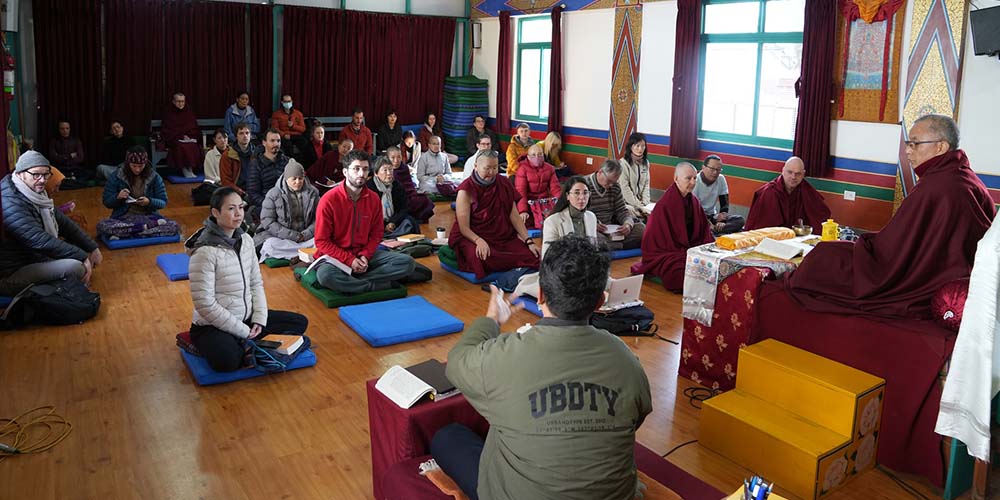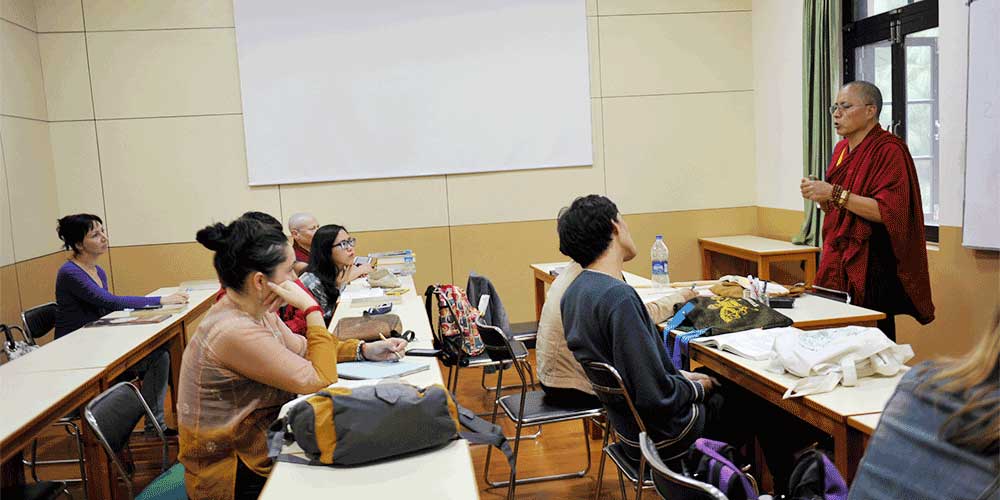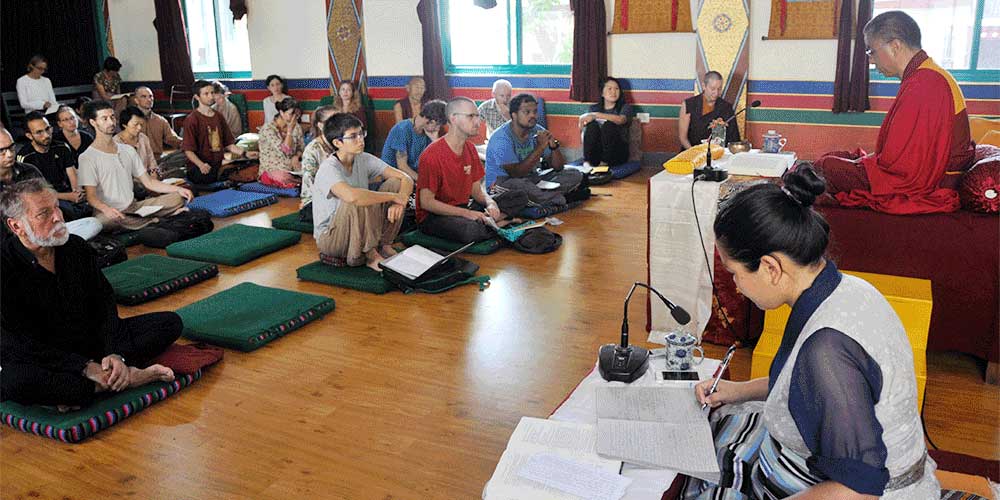First Buddhist Philosophy Class
Time: 9:00 to 10:15 am
Teacher: Geshe Gyaltsen Tsering
Text: Science and Philosophy in the Indian Buddhist Classics Tibetan Wylie: nang pa’i tshan rig dang lta grub kun btus Phonetics: Nangpé Tsenrig dang Tadrub Kuntü
4 March – 11 July
Text: Science and Philosophy in the Indian Buddhist Classics (nang pa’i tshan rig dang lta grub kun btus)
This year, Geshe Gyaltsen Tsering-la will teach Vol. II of Science and Philosophy in the Indian Buddhist Classics (nang pa’i tshan rig dang lta grub kun btus), starting from the second part “Mental Factors (sems byung gi rnam gzhag brgyas par bshad pa)”. The Science and Philosophy in the Indian Buddhist Classics consists of four volumes and compiles classical Buddhist explorations of the nature of our material world, the human mind, logic, and phenomenology and puts them into context for the modern reader.This four-volume series—a major resource for the history of ideas and especially the history of science and philosophy—was conceived by and compiled under the visionary supervision of His Holiness the Dalai Lama himself. It is his view that the exploratory thinking of great Indian masters in the first millennium CE still has much that is of interest to us today, whether we are Buddhist or not. These volumes make those insights accessible.
From 4 March to 11 July, Geshe-la will cover the second and third parts of Volume II.The second part (Mental Factors) focuses on the science of mind. It discusses distinguishing between mind and mental factors; the fifty-one mental factors presented in Asanga’s Compendium of Knowledge (mngon pa kun btus); the five omnipresent mental factors— feeling, discernment, intention, attention, and contact. Mental factors with a determinate object – aspiration, resolution, mindfulness, concentration, and wisdom. The third part presents the eleven virtuous mental factors: faith, shame, embarrassment, nonattachment, nonhatred, nondelusion, diligence, pliancy, heedfulness, equanimity. Then it goes on to deal with love and compassion. The six root mental afflictions: attachment, anger, pride, afflictive ignorance, afflictive doubt, and afflictive view. Four variable mental factors: sleep, regret, inquiry, and analysis. Part 3 (Gross and Subtle Mind) examines the degrees of coarseness and subtlety among mental states. If we look at human consciousness broadly, consciousness during life is grosser and consciousness at the time of death is subtle. Even while alive, within a twenty-four-hour cycle, consciousness while awake is gross, consciousness while dreaming is subtler, and consciousness during deep dreamless sleep is even subtler.Also, during the waking state, sense consciousness is grosser and mental consciousness is subtler. This part also explains the gross and subtle mind from the tantric perspective, especially from the highest yoga tantra point of view.
From 1 August to 13 December, the 4th, 5th and 6th parts of the Volume II will be covered. Part 4 “Mind and Its Objects” delves deep into the question how mind engages with its objects. It speaks about four types of objects of mind: appearing object (snang yul), observed object (gzung yul), conceived object (zhen yul), and engaged object (‘jug yul). To understand how the mind engages its object, it is crucial to recognize that there are two different ways in which it can do so: it can engage the object via exclusion, and it can engage the object via affirmation—or through the capacity of the real object itself.
Part 5 is on Inferential Reasoning. It includes topics of reasoning and rationality, categories of correct evidence, and fallacious inferential evidence. This part details how the mind engages with reality are: 1) four forms of rationality; 2) consequential reasoning, which is used as a way to eliminate distorted conviction; 3) proof statements, which are used as a way to eliminate doubt oscillating between two points of view, and 4) inferential evidence, which is used as a way to explicitly ascertain the object once those distorted cognitions have been dispelled. These four means are encompassed within the science of inferential evidence. What is called the “science of inferential evidence” means the same as the science of inferential reasoning. There is the section
on categories of correct evidence, which is of three types: correct effect evidence, correct nature-evidence, and correct evidence consisting in non-perception. After that, it explains fallacious inferential evidence and its subcategories. To facilitate an understanding of the very important categories of inferential evidence, Dignaga composed a text titled Drum of Wheel of Reasons, presenting nine specific types of evidence where the evidence is established as the attribute of the subject.
Part 6 or the final part of this volume is devoted to training the mind through meditation. This part details the method of training the mind aimed at goals such as enhancing the mind’s ability to determine its object and, while the mind is engaging with it, making it remain single-pointed calm abiding on that object. It shows the causes and conditions that create mental afflictions. It also deals with topics of calm abiding, and analysis and insight. It gives broad view of how to cultivate single-point mind calm abiding, and explains the nine stages of mental stabilization.
It further discusses the importance of mindfulness and meta-awareness. Mindfulness is the mental factor that prevents one from forgetting the object and its aspects that are to be adopted or abandoned. Meta-awareness is the mental factor that analyzes one’s conduct of body, speech, and mind from moment to moment and brings about an understanding of whether it is virtuous or non-virtuous. Both of these mental factors are very important not only at the time of learning and reflecting about what one needs to know but also in everyday life.
There is a section on the eight worldly concerns: gain and loss, fame and disrepute, pleasure and pain, praise and disparagement, and deals with how to gain equanimity towards these. Then there is a section that focuses on how to increase good qualities, such as wisdom and compassion. The last section gives a short note on the topic “the person or self”, cognizer of objects. It describes how the Buddhist view on “self” or “I” is different from other religions or philosophies.
Recommended text:
- Science and Philosophy in the Indian Buddhist Classics, Vol. 2, is available at the LTWA
sales counter.
 Library of Tibetan Works and Archives
Library of Tibetan Works and Archives




